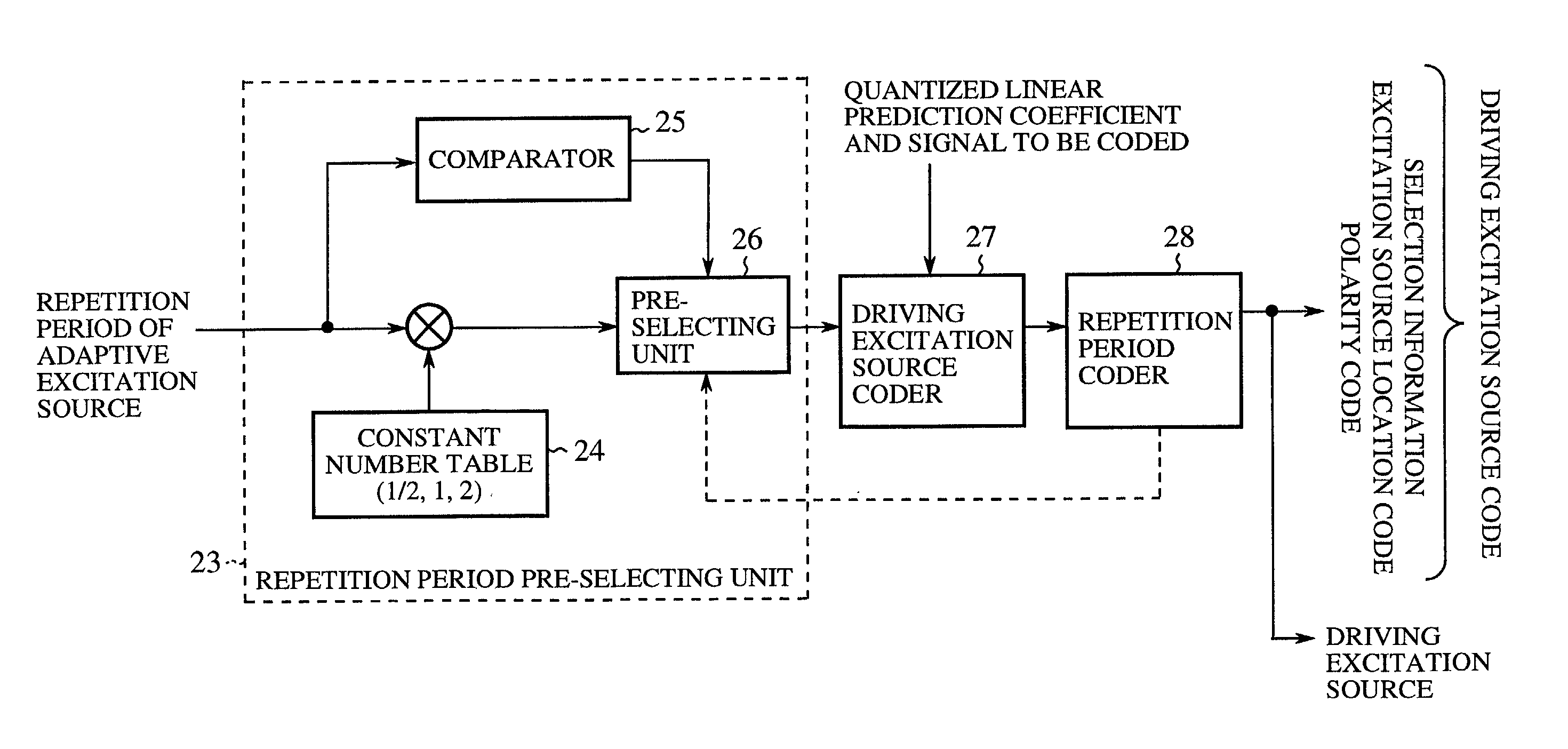Speech coding apparatus and speech decoding apparatus
a speech coding and speech technology, applied in the field of speech coding apparatus, can solve the problems of affecting the quality of speech code generated, the change in the tone quality of the frame and hence the inability to synthesize speech, and the inability to achieve the effect of reducing the disadvantage, and not negligibl
- Summary
- Abstract
- Description
- Claims
- Application Information
AI Technical Summary
Benefits of technology
Problems solved by technology
Method used
Image
Examples
embodiment 1
[0077]Referring next to FIG. 1, there is illustrated a block diagram showing the structure of a driving excitation source coding unit of a speech coding apparatus in accordance with a first embodiment of the present invention. The speech coding apparatus has the same overall structure as shown in FIG. 14. In FIG. 1, reference numeral 23 denotes a repetition period pre-selecting unit, numeral 27 denotes a driving excitation source coder, and numeral 28 denotes a repetition period coder. The repetition period pre-selecting unit 23 includes a constant number table 24, a comparator 25, and a pre-selecting unit 26.
[0078]The driving excitation source coding unit 5 of the speech coding apparatus of this embodiment thus includes the driving excitation source coder 27 that operates in the same way that the prior art driving excitation source coding unit as mentioned above does, and the repetition period pre-selecting unit 23 and the repetition period coder 28 disposed in the front and back o...
embodiment 2
[0104]Referring next to FIG. 5, there is illustrated a block diagram of a driving excitation source coding unit of a speech coding apparatus according to a second embodiment of the present invention. The overall structure of the speech coding apparatus of this embodiment is the same as that of the aforementioned first embodiment as shown in FIG. 14. In FIG. 5, reference numeral 31 denotes a repetition period pre-selecting unit, and numeral 33 denotes an adaptive excitation source code book contained in an adaptive excitation source coding unit 4. The repetition period pre-selecting unit 31 includes a constant number table 32, an adaptive excitation source generating unit 34, a distance calculating unit 35, and a pre-selecting unit 36.
[0105]The driving excitation source coding unit 5 of the speech coding apparatus of the second embodiment includes a driving excitation source coder 27 that operates in the same way that the prior art driving excitation source coding unit as mentioned a...
embodiment 3
[0134]Referring next to FIG. 10, there is illustrated a block diagram showing the structure of a driving excitation source coding unit 5 and a perceptual weighting control unit 37 disposed within a speech coding apparatus in accordance with a third embodiment of the present invention. The overall structure of the speech coding apparatus of this embodiment thus involves the additional perceptual weighting control unit 37 connected to the driving excitation source coding unit 5 in addition to the structure as shown in FIG. 14. The perceptual weighting control unit 37 includes a comparator 38 and a strength control unit 39. The driving excitation source coding unit 5 has the same structure as the conventional driving excitation source coding unit as shown in FIG. 17, with the exception that a perceptual weighting filter coefficient calculating unit 16 is controlled by the perceptual weighting control unit 37.
[0135]In operation, a linear prediction coefficient coding unit 3, as shown in...
PUM
 Login to View More
Login to View More Abstract
Description
Claims
Application Information
 Login to View More
Login to View More - R&D
- Intellectual Property
- Life Sciences
- Materials
- Tech Scout
- Unparalleled Data Quality
- Higher Quality Content
- 60% Fewer Hallucinations
Browse by: Latest US Patents, China's latest patents, Technical Efficacy Thesaurus, Application Domain, Technology Topic, Popular Technical Reports.
© 2025 PatSnap. All rights reserved.Legal|Privacy policy|Modern Slavery Act Transparency Statement|Sitemap|About US| Contact US: help@patsnap.com



